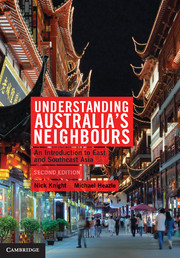Book contents
- Frontmatter
- Contents
- List of Maps
- Acronyms and abbreviations
- Acknowledgments
- Maps
- Introduction
- 1 The idea of ‘Asia’
- 2 Tradition and modernity in East and Southeast Asia
- 3 Tradition and modernity in East and Southeast Asia
- 4 Colonialism in East and Southeast Asia
- 5 Nationalism and revolution in East and Southeast Asia
- 6 Nations and nation-building in East and Southeast Asia
- 7 International politics and East and Southeast Asia
- 8 Economic growth in East and Southeast Asia
- 9 Democracy, human rights and development
- 10 Globalisation and East and Southeast Asia
- 11 China–Japan relations and US power in the twenty-first century
- 12 Australia in Asia, ‘Asia’ in Australia
- Bibliography
- Index
12 - Australia in Asia, ‘Asia’ in Australia
Published online by Cambridge University Press: 05 June 2012
- Frontmatter
- Contents
- List of Maps
- Acronyms and abbreviations
- Acknowledgments
- Maps
- Introduction
- 1 The idea of ‘Asia’
- 2 Tradition and modernity in East and Southeast Asia
- 3 Tradition and modernity in East and Southeast Asia
- 4 Colonialism in East and Southeast Asia
- 5 Nationalism and revolution in East and Southeast Asia
- 6 Nations and nation-building in East and Southeast Asia
- 7 International politics and East and Southeast Asia
- 8 Economic growth in East and Southeast Asia
- 9 Democracy, human rights and development
- 10 Globalisation and East and Southeast Asia
- 11 China–Japan relations and US power in the twenty-first century
- 12 Australia in Asia, ‘Asia’ in Australia
- Bibliography
- Index
Summary
AUSTRALIA'S RELATIONSHIP WITH ASIA, and particularly the East and Southeast Asian region, is normally conceived in terms of foreign policy and trade. From this perspective, Asia is external to Australia, and Australia's relationship with Asia is managed, particularly at a governmental level but also by the world of business, as though it is ‘out there’, separate and distinct from Australia. This undoubtedly mirrors the perspective of the bulk of Australia's population, which remains overwhelmingly of European origin and predominantly Anglo–Celtic. However, this conception of Asia as ‘out there’ sits awkwardly with Australian government rhetoric about the importance of Asia to Australia. Asia is vitally important, we are told, because so much of our trade is with Asia, particularly with China and Japan. Australian governments of different political persuasions have also expressed an interest in being included in regional forums on such issues as trade and security. The proportion of East and Southeast Asian-born people in Australia's population remains fairly low at 6.2 per cent, although this figure does not include the Australian-born children of migrants. People from East and Southeast Asia accounted for 30.7 per cent of the foreign-born population of Australia in 2009 (ABS 2010a: 46). This has contributed to the changing ethnic and cultural composition of Australian society, and has made it less and less credible to talk of Asia as though it is ‘out there’.
- Type
- Chapter
- Information
- Understanding Australia's NeighboursAn Introduction to East and Southeast Asia, pp. 220 - 238Publisher: Cambridge University PressPrint publication year: 2011



